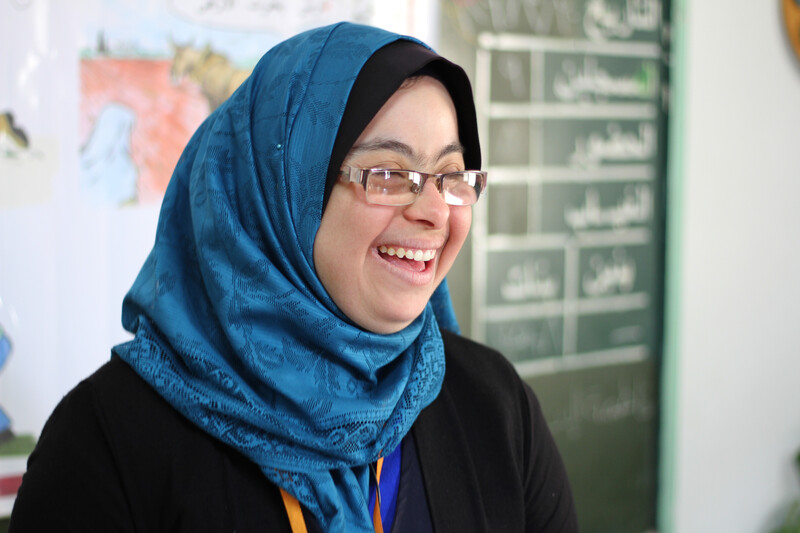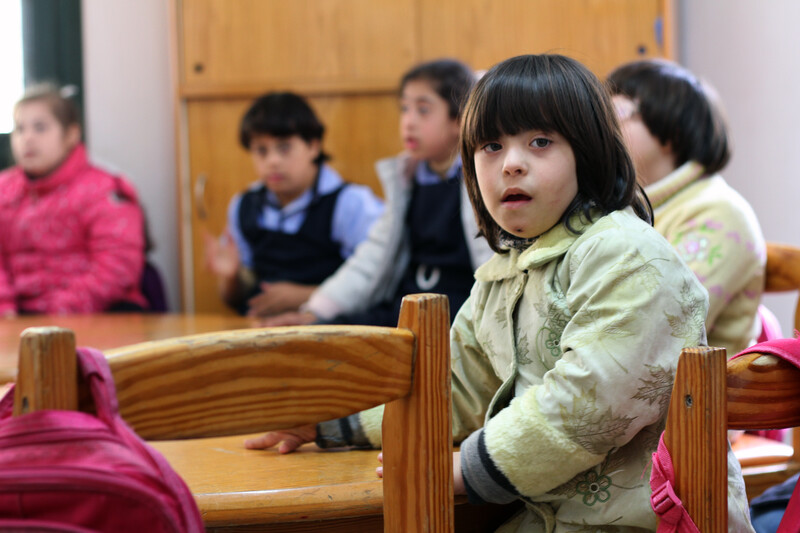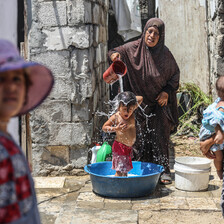The Electronic Intifada Gaza City 25 April 2016

“It’s hard, but I enjoy it,” says teacher Hiba al-Shurafa.
The children counted in unison. One to ten. Their teacher, by way of encouragement, applauded in appreciation when they had finished.
It might have been any class in any primary school in Gaza except for one thing: the teacher and students all had Down syndrome.
Hiba al-Shurafa, 26, seemed confident and relaxed. Her manner was friendly and keen and her students responded during this recent class at the Right To Live Association in the eastern part of Gaza City.
The Right to Live Society is Gaza’s chapter of Down Syndrome International, an organization for those born with the condition.
It is here that al-Shurafa was trained to become the first Down syndrome teacher in Gaza.
Family support
She teaches first and second grades a variety of subjects including mathematics, Arabic, science, religion, social studies and English.
Family support was crucial. Al-Shurafa was born in the United Arab Emirates, where her parents knew at once of her condition.
Nuha Abu Shaban, Hiba’s mother, told The Electronic Intifada that when Hiba was just six weeks old, she took her to the Emirate of al-Sharjah, and what is now the Sharjah City for Human Services.
There, Abu Shaban took awareness sessions, learning how to deal with a child who had Down syndrome and what to look out for in raising a person with the condition. And the family went further still.
“We contacted friends from Britain to send us books, magazines and manuals from the Down Syndrome Association,” said Abu Shaban. “Her father translated these for me to study and learn how to best address Hiba’s needs.”
Challenges
The bell rang and math class ended. Al-Shurafa asked her students to stay for a short question and answer session with this reporter. And in front of them she acknowledged that teaching had at first been a real challenge.
“At the beginning, I found it difficult to transmit information to the students,” she said. “Now I am beginning to feel comfortable.”
But teaching at the society involves more than simply imparting information. There are physical impairments to work with and al-Shurafa follows a program that includes how to help some students loosen their muscles in order to grip a pen.
She also teaches parents these exercises, which often involve specially-shaped clay, so that families can follow up at home.

Hiba al-Shurafa hopes to be an example for her young students.
And like any teacher, al-Shurafa’s job has its ups and downs. The hardest thing to deal with, she said, are problems between students.
“Some are stubborn, they can be difficult to teach and control,” she said. “It’s hard, but I enjoy it.”
She has also become an example to others. Shaima Qufah, who sits in the front row and watches her teacher carefully, admitted that she wanted to follow in al-Shurafa’s footsteps.
“I want to be like her,” the 6-year-old said in a quiet voice when asked. Al-Shurafa smiled.
Nothing, she said, should stop Shaima from becoming a teacher.
Changing mindsets
For 20 years, the Right to Live Society has been the only dedicated support organization for those with Down syndrome in Gaza. The association has one core message: people with Down syndrome need to be included as full members of society.
Social attitudes, said Nabil Juneid, head of rehabilitation programs at the society, are the greatest obstacle.
Parents may pay less attention to children with the condition than to their other children. People with Down syndrome may be ostracized or shunned and their opportunities are likely to be restricted.
Overall, said Juneid, people with Down syndrome are seen as a burden.
“Such attitudes demand special efforts either from the association or from parents to effect more general change,” Juneid added.
Juneid estimated that between 1,500 and 2,000 people in Gaza have Down syndrome. The society helps about 900, all children, he said.
“The key element for Hiba is her parents’ care and a supportive environment,” Juneid added. “These combined allowed her to express herself creatively and academically and has allowed her to become a professional teacher. As a result, she has benefitted more than most from the [Right to Live] society.”
Al-Shurafa’s parents tried to provide her with a stimulating upbringing. The young Hiba accompanied her mother constantly, which allowed others to warm to her. The result was to “erase differences” between her and others, her mother, Nuha Abu Shaban, said.
Al-Shurafa, moreover, has little of the speech impediments that can be found in others and has a strong memory, Juneid said. She has a knack of memorizing the poems of Imam al-Shafi, better known as one of the great imams after whom one of Islam’s four bodies of jurisprudence is named.
“We are always encouraging her,” Juneid said. “She has won plenty of prizes for her poetry recitals.”
Success in adversity
Like everything else in Gaza, the Right to Live Society is directly affected by Israel’s blockade of the strip, now almost a decade old. With no ability to ensure supplies, the association has had to close two workshops for occupational training, one that produced carpets and one for bamboo products.
The society’s building, situated on Gaza City’s easternmost highway, Karama Street, not far from the boundary with Israel, was also damaged during Israel’s 2014 assault on Gaza, as well as in previous military onslaughts.
Students still engage in occupational training and also take sports lessons with qualified staff. But Juneid said it was an uphill battle to ensure quality and progress.
“Apart from the damage wrought by the siege and three wars in the past 10 years, the society needs many human and financial resources to offer enough services and ensure positive outcomes,” he said.
And, he added, there is no better way to increase awareness and counter social stigma then through success stories like that of al-Shurafa.
Back in class, al-Shurafa asked the students to stand and say goodbye to this reporter.
“I hope,” she said, “society can accept us as we are. Maybe my story can change any negative opinions people have of us.”
Hamza Abu Eltarabesh is a journalist from Gaza.



